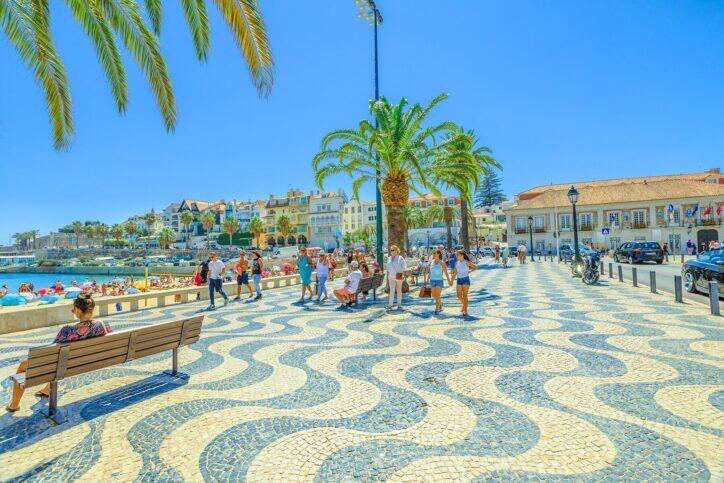What's the best time to visit this sunny European destination?
Boasting a yearly average of 300 days of sunshine, Lisbon, Portugal is a top-tier destination year-round. It’s important to note that Portugal is a relatively conservative country and locals dress for the season, rather than the weather. So winter means beautiful layers of clothing, including chunky sweaters, denim, knee-length coats, hats, scarves, and gloves. In the summer, expect to see soft linen and light cotton dresses, shorts, and shirts. Like many European capitals, Lisbon isn’t known for its abundance of air-conditioning, choosing instead to rely on other elements like the breeze from the Tejo River, shade from trees, or ice-cold beer (cerveja) to help the body regulate its temperature.
In this article, we’ll explain how to prepare for the weather and when is the best time to visit Lisbon, Portugal according to individual factors like budget, interests and of course, temperature.
Preparing for Your Trip—What Are the Seasons Like in Lisbon, Portugal?
Portugal has four distinct seasons that vary depending on the region. For example, while the northern region of Portugal tends to see more rain and cooler temperatures, the southern region experiences a drier climate and warmer temperatures. Nestled in the middle of the picturesque country, Lisbon has a fairly comfortable temperature no matter the season.
Recommended Fodor’s Video

Winter in Lisbon
Winter in Lisbon is typically mild with daytime temperatures averaging 59°F (15°C) and 61°F (16°C) in December and January,. The sunrise times are usually between 7 am and 8 am while the sun sets somewhere between 5 pm and 6 pm (and lasts about 30 minutes). The rainiest months are November and December. It’s imperative to wear reliable footwear that has a strong grip due to the iconic yet uneven slippery cobblestone pathways.

Spring in Lisbon
Spring in Lisbon brings about a delightful transformation as temperatures gradually rise, making it an ideal time to explore the city’s charming streets and vibrant outdoor cafes. By March, daytime temperatures start to climb, averaging around 63°F (17°C), with April and May seeing highs of approximately 68°F (20°C) and 73°F (23°C) respectively. The city begins to bloom with colorful flowers, and the sunsets extend into the evening hours, with sunset times ranging from 7:30 pm to 8:30 pm, allowing for leisurely strolls along the waterfront or romantic dinners with a view of the Tagus River.

Summer in Lisbon
Summer in Lisbon heralds warm and sunny days, making it the perfect season for beachgoers and outdoor enthusiasts. From June to August, temperatures soar, with daytime averages hovering around 77°F (25°C) to 82°F (28°C), occasionally reaching highs of 86°F (30°C) or more. The city comes alive with festivals, concerts, and outdoor events, drawing locals and tourists alike to its lively streets. With the sun setting as late as 9 pm to 9:30 pm during the peak of summer, evenings are balmy and inviting, offering ample opportunities to savor delicious seafood dinners alfresco or enjoy a leisurely sunset cruise along the coast.
Autumn in Lisbon
Autumn in Lisbon brings a refreshing change as the summer heat gradually subsides, and the city embraces cooler temperatures and a more relaxed atmosphere. September still retains some warmth, with daytime temperatures averaging around 77°F (25°C), while October sees a slight dip to around 72°F (22°C). By November, temperatures cool further, settling at around 64°F (18°C), creating pleasant conditions for exploring Lisbon’s historic neighborhoods and picturesque parks. As the days grow shorter, sunset times gradually shift earlier, ranging from 6:30 pm to 5:30 pm by the end of November, casting a golden hue over the city’s iconic landmarks and providing a scenic backdrop for evening walks along the cobblestone streets.
When Is the Best Time to Visit Lisbon, Portugal?
While Lisbon, Portugal is universally regarded as great to visit year-round, the best times to visit are in the autumn (September and October) and spring (March to May). Autumn is perfect for many reasons. The summer heat is weaning and the prices of airfare and accommodation start to decrease. It’s also one of the best times to travel here on a scenic cruise. During this time, Lisbon also boasts some of the most magnificent sunsets that display golden, fierce, and fiery hues that envelop the city with delicate tones reminiscent of cotton candy.
Alternatively, prices skyrocket as Lisbon prepares for the influx of visitors during the festive season. Once the winter holidays are over the prices drop again as the weather quickly warms up and nature seemingly comes back to life. As you walk the seven hills, explore the outskirts of the city or relax in one of the city’s luscious parks–you’ll find the streets and walkways adorned with color-rich floral and citrus-filled bushes and trees.
To get a better sense of what Lisbon, Portugal has to offer, check out our guide featuring interesting facts including the top 5 things to know about the city, things to see and do, and where to stay.

When Is the Worst Time to Visit Lisbon, Portugal?
Like other South Western European countries, Portugal virtually shuts down in August—and Lisbon is no different. During this month many businesses close up shop for at least two weeks and families take the opportunity to go on vacation (festas). While August is the perfect time to take advantage of Portugal’s blissful beaches, it may leave you wanting if exploration is the focus of your trip. Imagine hundreds of closed restaurants, boutiques, and attractions. August is also Lisbon’s hottest month, and for those accustomed to basking in well-air-conditioned establishments and abodes, the heat can feel sweltering.
The best way to prepare for a trip during this time is to research all the activities and places you’d like to see and do before you arrive. If there’s a restaurant or two you’re dying to try, try to touch base with them to confirm their hours of operation. Nowadays, many can be contacted via social media while some of the older establishments can be contacted through their company website. Although social media is becoming more of a “thing” in recent years, not all businesses rely on it for marketing, which means you’ll encounter hours of operations that haven’t been updated every now and then (or they’ll simply post a sign on their door).
It’s just one of the aspects of traditional living that make Lisbon, Portugal a uniquely fantastic destination. Plus, you can always use any missed opportunities as a chance to revisit—and hopefully, the thought will keep a smile on your face.



